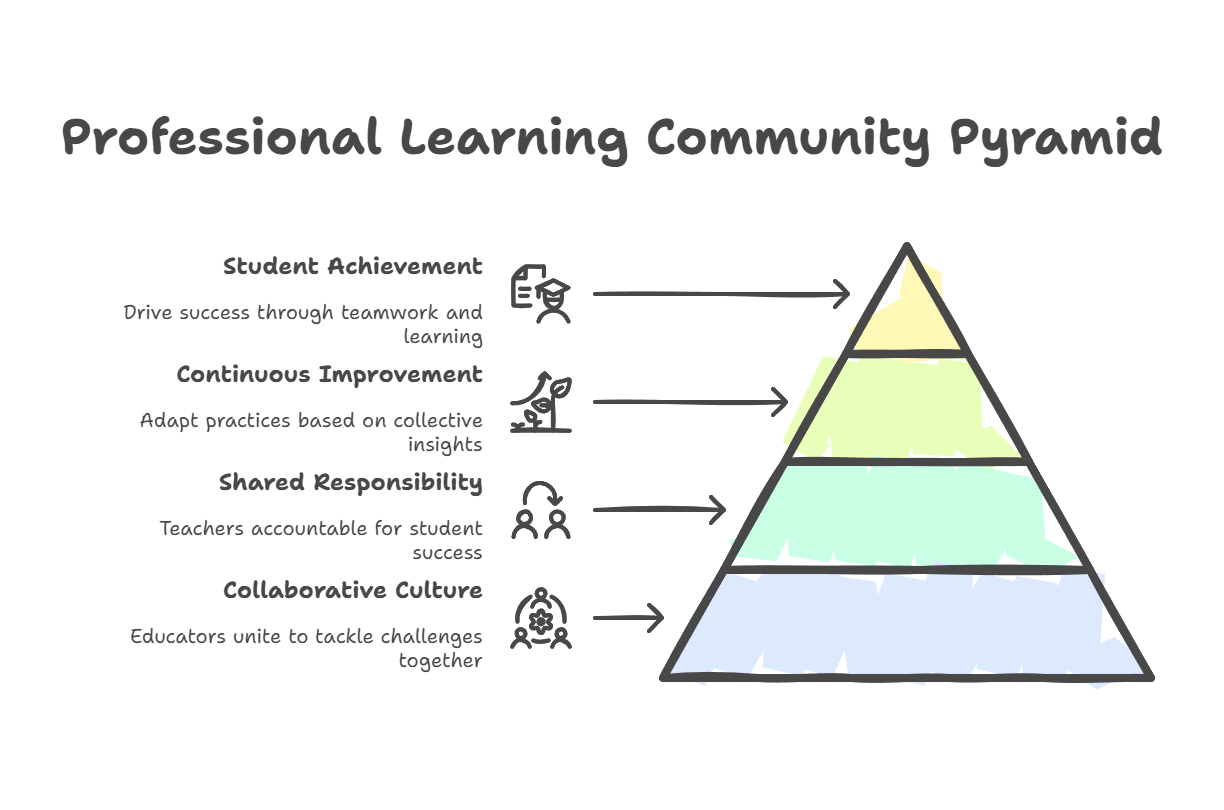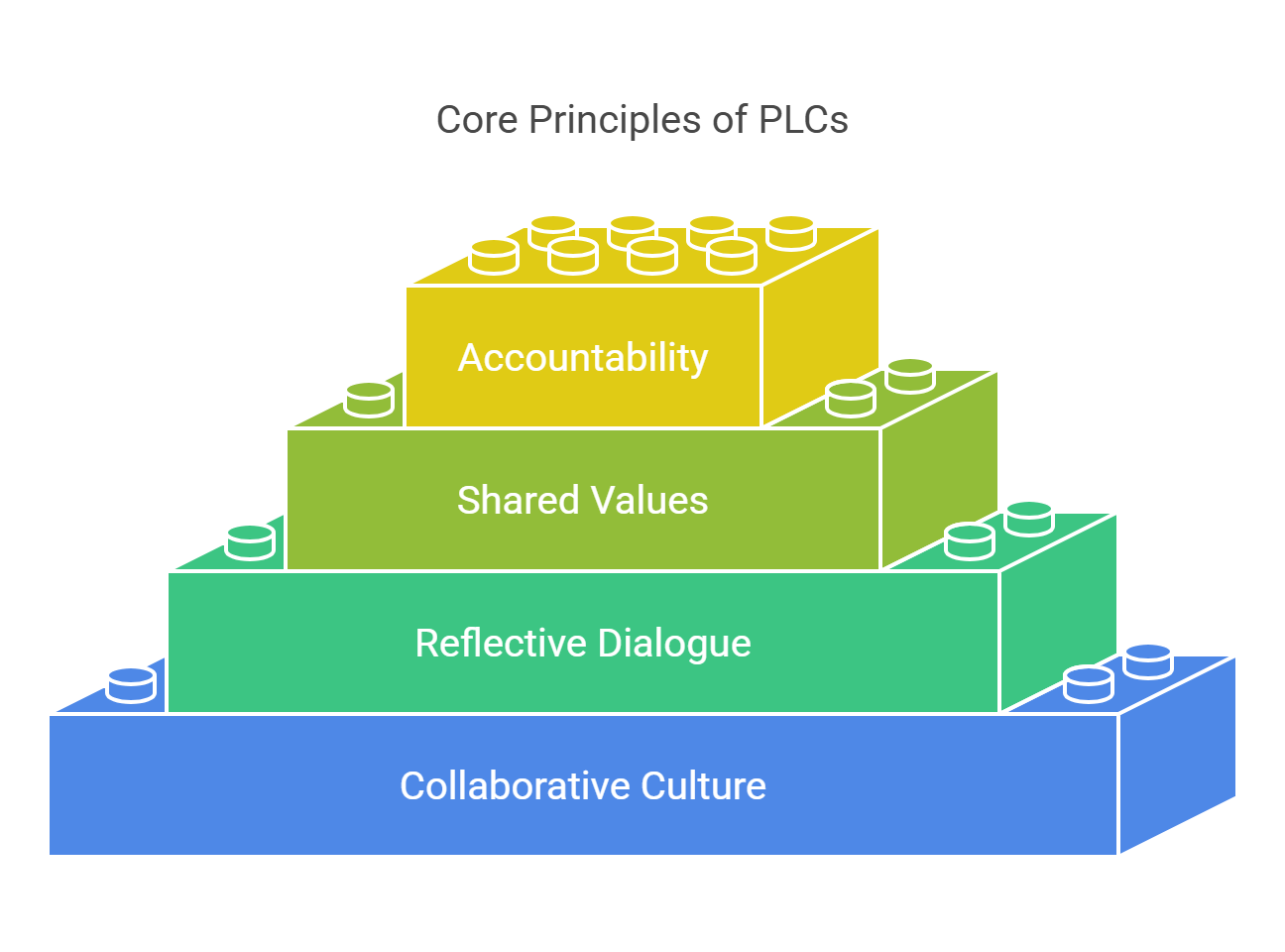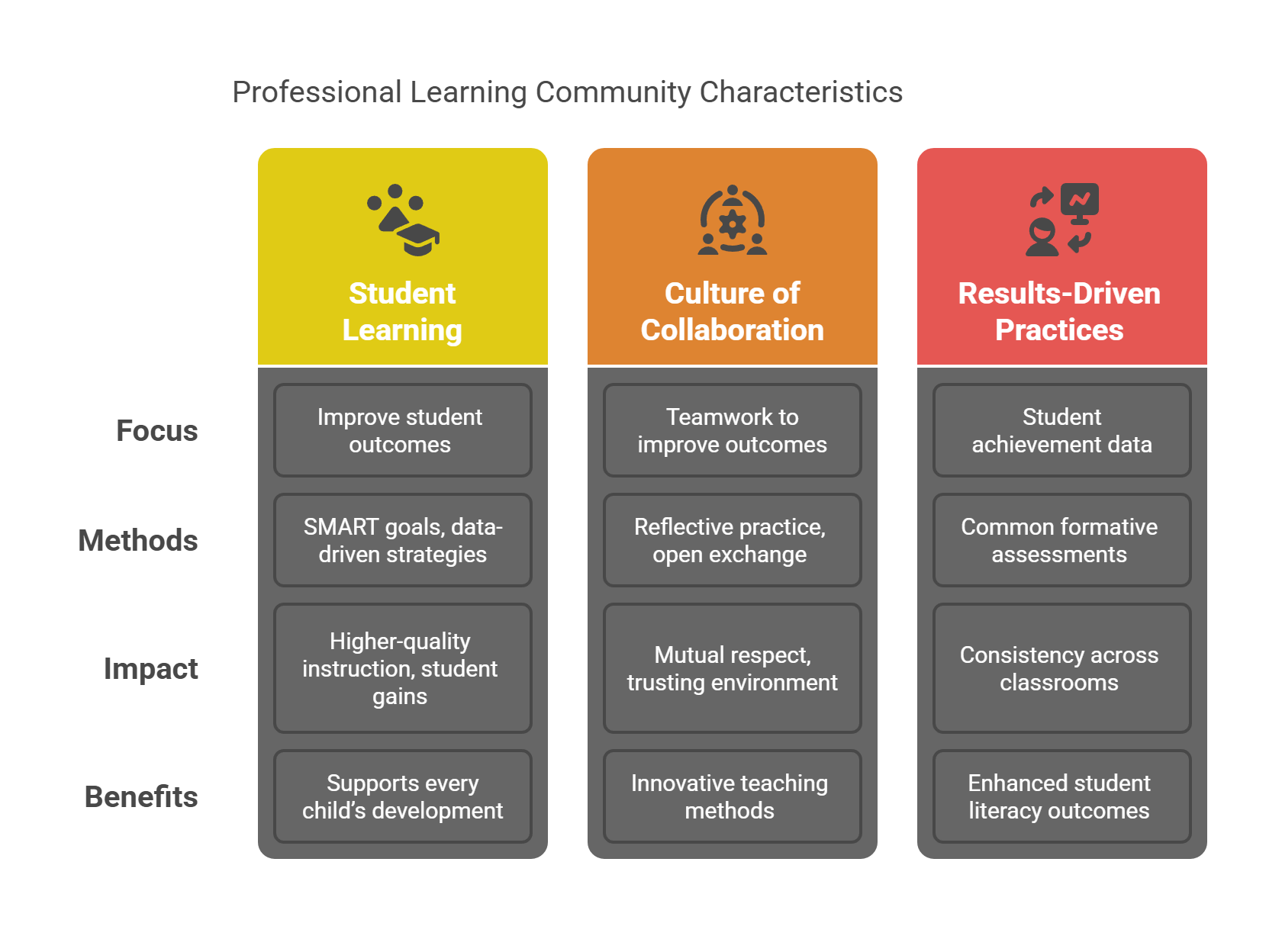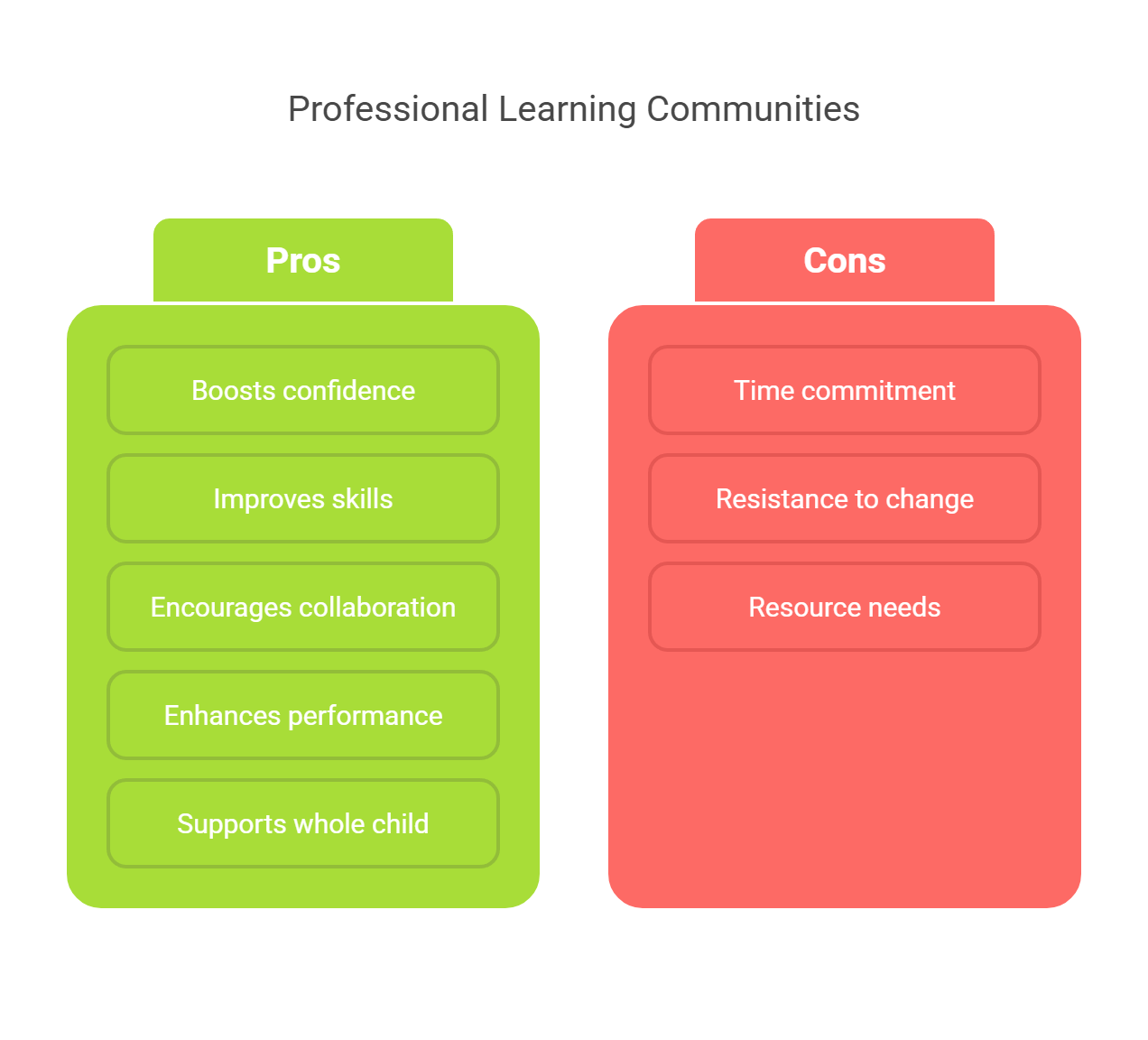A professional learning community brings teachers together to improve their teaching methods and boost student learning. Unlike a school committee, which focuses on planning academic programs, a professional learning community emphasizes ongoing collaboration among educators to support professional growth.
This guide explores what makes a professional learning community, its core principles, key components, and benefits, showing how it stands apart from traditional professional development approaches.
Key Takeaways
- Professional Learning Communities (PLCs) emphasize collaboration among educators to enhance teaching skills and improve student performance through a focus on collective responsibility.
- PLCs can include the entire teaching staff working collaboratively to improve teaching practices and student outcomes.
- Core principles of PLCs include collaboration, shared knowledge, and a culture of continuous improvement, which encourages effective professional development and mutual respect among educators.
- PLCs differ from traditional meetings by focusing on data-driven, results-oriented discussions that are relevant to student learning, ensuring all activities contribute to meeting school and district goals.
Defining Professional Learning Communities

A professional learning community is a collaborative model where educators meet regularly to refine their teaching skills and improve student outcomes. These learning communities operate within a school or across school districts, providing structured spaces for professional learning.
Unlike traditional settings where individual teachers might work alone, a professional learning community prioritizes teamwork and continuous improvement to drive student achievement.
Here’s why this matters. Teachers in a professional learning community share responsibility for student success, holding each other accountable through thoughtful discussions and practical solutions. This systematic process helps educators adapt their classroom practices based on collective insights, supporting teacher development and educational leadership.
Online communities, like virtual PLC platforms, allow teachers to exchange lesson plans and strategies across grade levels, creating a dynamic learning environment.
This approach builds a collaborative culture, where educators tackle challenges together, share student progress, and align with school and district goals.
When educators unite around the goal of student learning, professional learning communities breathe new life into teaching, ensuring methods are both impactful and attuned to what students truly need.
Core Principles of PLCs

Now, let’s dive into the foundation of a professional learning community, which comprises teamwork, shared knowledge, and accountability, all of which form the core principles that guide these groups.
First, a collaborative culture encourages teachers to work together consistently, improving classroom practice and student achievement through joint efforts.
This brings us to action. Secondly, teachers can engage in reflective dialogue, discussing teaching methods and analyzing their impact. This ongoing cycle of reflection and adjustment helps educators refine their approaches, ensuring continuous improvement.
Here is a stat to strengthen this principle: schools implementing effective professional learning communities (PLCs) experienced a 21% increase in student performance over three years. This focus on learning by doing pushes teachers to apply new strategies in their classrooms immediately.
Beyond these, when staff connect through shared values and open communication, trust is built. A professional learning community that aligns its efforts with school goals empowers teachers to grow professionally while creating an enriching environment that benefits everyone in the classroom.
How PLCs Differentiate from Traditional Meetings
Unlike standard staff meetings that cover various topics, a professional learning community focuses solely on improving student learning through sustained alliance. Traditional professional development often involves one-off workshops, but a professional learning community provides an ongoing, tailored experience that meets the specific needs of teachers and students.
Let’s explore the difference. PLC meetings center on data-driven discussions, where educators analyze student achievement data and brainstorm innovative ways to address challenges.
Teachers quickly apply these insights to their lesson plans, creating immediate improvements in the learning process. This contrasts with disjointed traditional meetings, making a professional learning community a more effective way to support teaching practice and student outcomes.
Keeping discussions targeted on practical goals linked to school advancement, this strategy maintains alignment and purpose. Through joint problem-solving and idea-sharing, professional learning communities engage in a cycle of growth that sets them apart from typical school committees.
Components of Effective PLCs

What makes a professional learning community work? They can be found in three key components:
- Focus on student learning,
- Collaborative culture,
- Results-driven practices.
The next sections break down these components, showing how they drive success in a professional learning community and improve student success across educational subjects.
Focus on Student Learning
The essence of a professional learning community is a commitment to student learning. Every action aims to improve student outcomes, using clear goals and data to guide efforts. Teachers set SMART (Specific, Measurable, Achievable, Relevant, Time-bound) goals, monitor progress with dashboards, and use evidence-based strategies to identify needs.
Here’s how it works. Educators review frequent common formative assessments to understand student performance and support struggling students with targeted interventions. Such a data-driven approach ensures essential outcomes are met, aligning with school and district goals.
What do the experts say? A groundbreaking study reveals that science teachers who engaged in weekly professional learning community sessions over two years experienced remarkable growth.
An impressive 88.2% reported significant improvements in their assessment practices, with PLCs driving enhancements in both summative and formative assessments.
These improvements didn’t just stay on paper, they translated directly into higher-quality instruction and measurable gains in student achievement.
Beyond grades, a professional learning community tracks student growth, sharing progress to create a learning environment that supports every child’s development, ensuring concepts students find challenging are addressed for lasting success.
Culture of Collaboration
A professional learning community thrives on teamwork. Collaborative teams of teachers reflect on their teaching practice, analyzing strategies together to improve student outcomes. This open exchange builds mutual respect and creates a trusting space for discussing challenges.
Consider this. Teachers share ideas during PLC meetings, valuing each member’s input to develop innovative teaching methods. This collaborative culture supports cross-curricular projects, where educators learn from each other across grade levels. By sharing student progress, teams adjust strategies to meet individual needs, strengthening the learning community.
Moreso, this teamwork creates a positive atmosphere, encouraging staff members to take risks and try new approaches. A professional learning community’s collaborative spirit drives professional growth, making teaching more effective and engaging for students.
Results-Driven Practices
Results matter in a professional learning community. Teachers should focus on student achievement data to make decisions, ensuring their efforts lead to measurable improvements. These assessments help educators identify gaps and adjust teaching methods to meet intended outcomes.
Here’s the catch. Collaborative teams at the same grade level create common formative assessments to check student understanding, sharing results to refine instruction. This systematic process ensures consistency across classrooms, supporting continuous improvement.
Research backs this up: implementing a grade-wide literacy intervention through a professional learning community significantly improved instructional and assessment practices, leading to enhanced student literacy outcomes.
This focus on evidence keeps a professional learning community effective, aligning actions with school goals and driving student success through practical, results-oriented strategies.
The Role of Leadership in PLCs
Strong leadership is essential to keeping a professional learning community focused and effective. Both administrators and educators can come together to establish meeting norms, develop clear protocols, and promote collective decision-making, ensuring the group operates smoothly.
Now, let’s shift to empowerment. Teachers are encouraged to take on leadership roles, like leading discussions or mentoring peers, which builds their skills and strengthens the professional learning community. This shared responsibility sharpens the focus on student learning, allowing educators to address individual challenges while supporting school improvement.
All in all, the collaborative leadership approach nurtures a culture of ongoing accountability, empowering professional learning communities to stay focused on their goals and consistently develop student achievement.
Learning Environments that Support PLCs
A professional learning community needs the right setting to succeed. Schools play an important role in creating conditions for collaboration by providing time, space, and tools for teachers to work together, improving student learning.
This leads us to specifics. Dedicated meeting times, like common planning periods, allow educators to share ideas and analyze data without distractions. Additionally, learning management systems and other management systems help teachers track student progress and continue discussions beyond the classroom door, even across school districts.
At the heart of this ecosystem is a supportive school culture. Strong educational leadership encourages open communication and professional growth, setting a tone where teachers feel valued. Whether organized by grade level or shared interests, a professional learning community stays focused on student success, creating various learning environment.
Professional Growth and Development in PLCs
A professional learning community is a powerful way for teachers to grow. Unlike one-time workshops, these communities provide ongoing professional learning, where educators share expertise and explore new teaching methods.
Here’s why it works. Teachers discuss challenges, learn about educational technology, and adapt strategies to meet student needs, improving classroom practice. PLC members take on roles like facilitating meetings, building leadership skills that benefit the entire teaching staff. Reflection helps educators assess their teaching, setting goals for continual improvement.
That way, teachers are engaged and motivated, creating a learning community where professional growth directly supports student achievement.
Benefits of Professional Learning Communities

A professional learning community delivers clear benefits for teachers and students:
- Builds teacher confidence and teamwork.
- Improves teaching skills and professional development.
- Provides regular chances to share ideas and plan together.
- Boosts student performance, aligning with school goals.
- Supports whole child learning by personalizing education.
These communities also create a nurturing environment. Recognizing small wins keeps teachers motivated, while mentorship helps new educators stay, supporting staff continuity. A professional learning community’s collaborative culture improves the learning environment for everyone.
Overcoming Barriers to Effective PLC Implementation
Starting a professional learning community, just like any other meaningful initiative, comes with its own share of challenges, whether it’s finding the time or overcoming resistance to change. However, by clearly communicating the benefits and thoughtfully scheduling meetings during non-teaching hours, schools can create the space teachers need to collaborate and grow together.
This brings us to technology. Virtual platforms make PLC meetings accessible, helping educators connect regardless of their locations. When these barriers are tackled, it can help schools create a professional learning community that supports student outcomes and builds a supportive culture among staff members.
Sustaining a Professional Learning Community
The strength of a professional learning community lies in its unified effort and dedication to advancing student achievement. With well-defined goals and ongoing evaluation of student progress, the team stays aligned and purposeful in improving results.
Now, consider longevity. Frequent PLC meetings and open communication let teachers share ideas and address challenges. Ongoing professional development ensures educators stay current, while new members bring fresh perspectives, keeping the professional learning community inclusive.
Through this adaptability, a professional learning community remains responsive to changing needs, maintaining a consistent cycle that drives continuous improvement of teaching practices and student outcomes.
Future Trends in Professional Learning Communities

As education changes, a professional learning community must stay relevant. One of the most transformative advancements is artificial intelligence, which enables personalized instruction tailored to each student’s unique needs, particularly benefiting special education. PLCs use these tools to improve teaching methods and student outcomes.
Looking beyond K-12, professional learning communities are broadening their reach into higher education and corporate environments, demonstrating remarkable flexibility.
They support collaboration across educational subjects, like literacy or technology, and use social media to connect educators globally, sharing innovative ways to teach, enriching learning experiences everywhere.
In embracing these emerging trends and technologies, professional learning communities don’t just keep pace, they set the standard for dynamic, future-ready education that supports both teachers and student success in an ever-changing world.
Summary
Being part of a professional learning community isn’t just about attending meetings or sharing lesson plans. It’s about joining a vibrant network of educators who are passionate about growth.
When teachers come together with a shared commitment to student success, they stimulate new ideas, challenge each other, and celebrate progress. With strong leadership and a culture that encourages experimentation, these communities adapt to change and tackle challenges head-on.
The result? Classrooms where both teachers and students experience continuous success, and where every day brings new opportunities to make a difference. Therefore, by embracing collaboration, educators can build a foundation for lasting impact—one that reaches far beyond the walls of any single classroom.
If you’re ready to make a difference in your teaching journey, join the Education Walkthrough community today and connect with passionate educators who are shaping the future of learning.
Frequently Asked Questions
What is a professional learning community (PLC)?
A professional learning community is a group of educators who meet regularly to improve their teaching skills and student learning. This collaborative effort creates a space for continuous professional growth and shared responsibility.
What is the main focus of a PLC?
A professional learning community prioritizes student learning and professional growth, focusing on collective efforts to improve teaching practices rather than traditional teaching methods.
How do PLCs benefit from collaboration?
Collaboration in a professional learning community allows teachers to share ideas, work toward shared goals, and take collective responsibility for student success, improving the learning process.
What are the core principles of PLCs?
A professional learning community is built on collaboration, a shared vision, and collective responsibility, creating a supportive environment that improves student outcomes and teaching practices.
What is the role of leadership in PLCs?
Leadership in a professional learning community sets norms, encourages collaboration, and promotes continuous improvement, empowering teachers to take on roles that support student learning.






